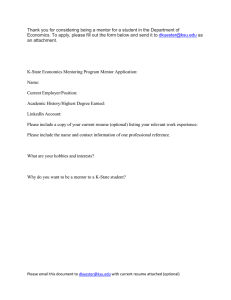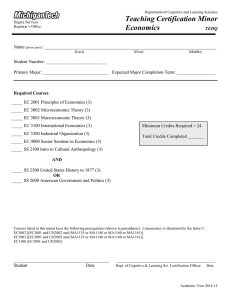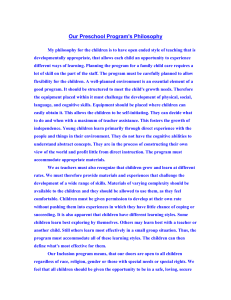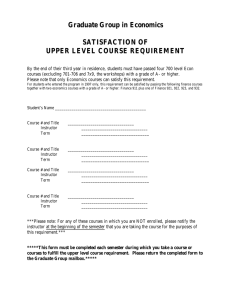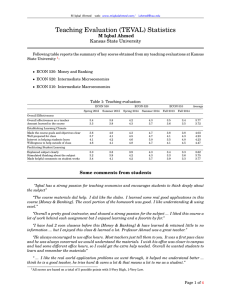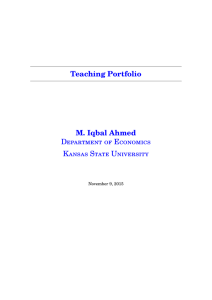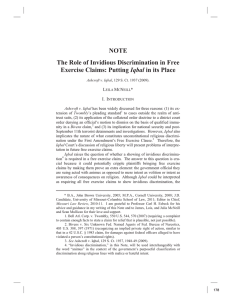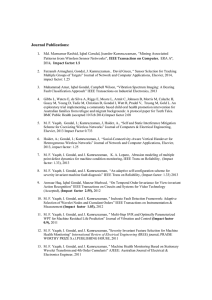Statement of Teaching Philosophy M Iqbal Ahmed
advertisement
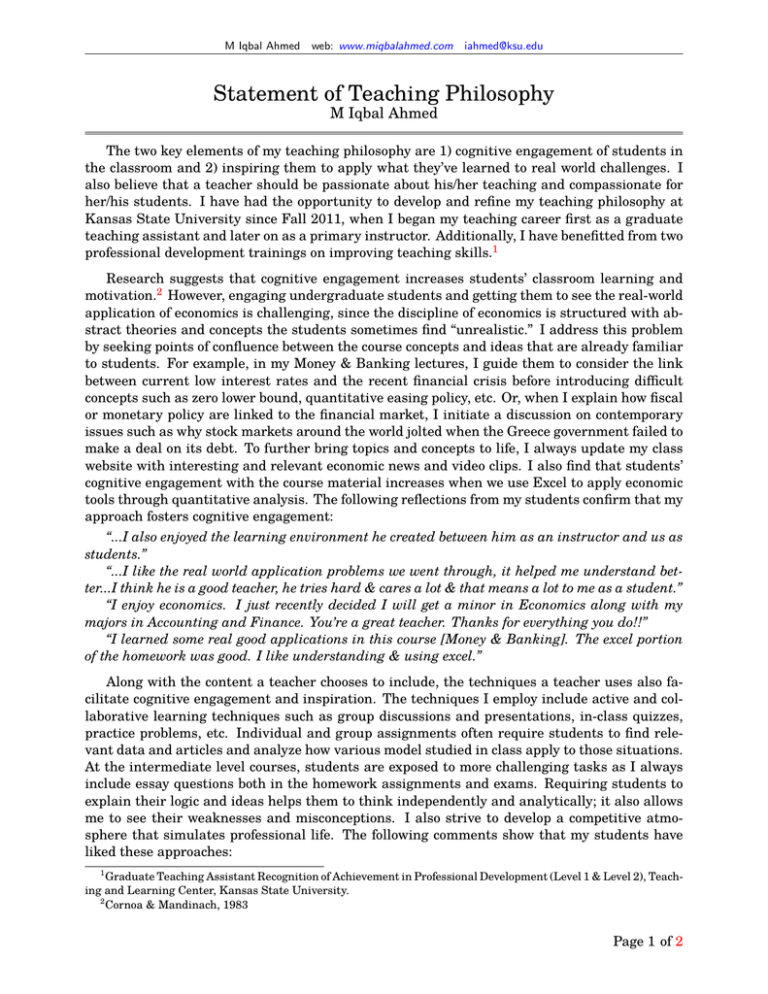
M Iqbal Ahmed web: www.miqbalahmed.com iahmed@ksu.edu Statement of Teaching Philosophy M Iqbal Ahmed The two key elements of my teaching philosophy are 1) cognitive engagement of students in the classroom and 2) inspiring them to apply what they’ve learned to real world challenges. I also believe that a teacher should be passionate about his/her teaching and compassionate for her/his students. I have had the opportunity to develop and refine my teaching philosophy at Kansas State University since Fall 2011, when I began my teaching career first as a graduate teaching assistant and later on as a primary instructor. Additionally, I have benefitted from two professional development trainings on improving teaching skills.1 Research suggests that cognitive engagement increases students’ classroom learning and motivation.2 However, engaging undergraduate students and getting them to see the real-world application of economics is challenging, since the discipline of economics is structured with abstract theories and concepts the students sometimes find “unrealistic.” I address this problem by seeking points of confluence between the course concepts and ideas that are already familiar to students. For example, in my Money & Banking lectures, I guide them to consider the link between current low interest rates and the recent financial crisis before introducing difficult concepts such as zero lower bound, quantitative easing policy, etc. Or, when I explain how fiscal or monetary policy are linked to the financial market, I initiate a discussion on contemporary issues such as why stock markets around the world jolted when the Greece government failed to make a deal on its debt. To further bring topics and concepts to life, I always update my class website with interesting and relevant economic news and video clips. I also find that students’ cognitive engagement with the course material increases when we use Excel to apply economic tools through quantitative analysis. The following reflections from my students confirm that my approach fosters cognitive engagement: “...I also enjoyed the learning environment he created between him as an instructor and us as students.” “...I like the real world application problems we went through, it helped me understand better...I think he is a good teacher, he tries hard & cares a lot & that means a lot to me as a student.” “I enjoy economics. I just recently decided I will get a minor in Economics along with my majors in Accounting and Finance. You’re a great teacher. Thanks for everything you do!!” “I learned some real good applications in this course [Money & Banking]. The excel portion of the homework was good. I like understanding & using excel.” Along with the content a teacher chooses to include, the techniques a teacher uses also facilitate cognitive engagement and inspiration. The techniques I employ include active and collaborative learning techniques such as group discussions and presentations, in-class quizzes, practice problems, etc. Individual and group assignments often require students to find relevant data and articles and analyze how various model studied in class apply to those situations. At the intermediate level courses, students are exposed to more challenging tasks as I always include essay questions both in the homework assignments and exams. Requiring students to explain their logic and ideas helps them to think independently and analytically; it also allows me to see their weaknesses and misconceptions. I also strive to develop a competitive atmosphere that simulates professional life. The following comments show that my students have liked these approaches: 1 Graduate Teaching Assistant Recognition of Achievement in Professional Development (Level 1 & Level 2), Teaching and Learning Center, Kansas State University. 2 Cornoa & Mandinach, 1983 Page 1 of 2 M Iqbal Ahmed web: www.miqbalahmed.com iahmed@ksu.edu “I am an Econ major. He is by far, the best instructor we had in any class at K-State period. He was very effective presenting materials, assigning homework, and relevant exercises to absorb the material.” “ ...the class was effective to learn about microeconomic theories and tools. He provided lots of practice exercises that were very helpful in making me think hard about the concept. “Very effective way to learn. Iqbal did a very good job of teaching this class. I could tell that he is passionate about teaching and truly cared about our learning.” “Overall a pretty good instructor, and showed a strong passion for the subject...I liked this course [Money & Banking], a lot of work behind each assignment but I enjoyed learning and a favorite by far.” Finally, I strongly believe that a teacher must exhibit care for their students. Effective teachers are always aware of the collective welfare and the general well-being of their students. I understand first-hand how life factors such as work load, financial issues, family issues, etc., impact students’ academic success. I take these situations seriously, counseling distressed students and assisting them outside of class if they need extra help with the course content. I am always available to help students during regular office hours or by appointment, as well as through emails or K-State’s online chatroom. I often rely on technology to connect with and help students who struggle in my class. I also find these platforms very effective for communicating with introverted students who hesitate to participate within the classroom. Following are some comments from my students that showing they knew I cared about their well-being and success: “He always encouraged to use office hours. Most teachers just tell them to you” “Great teacher. Knows the stuff and works hard. Reaches out to the students that need help.” In conclusion, it is important that my teaching philosophy reflect through my students’ accomplishments. It always motivates me to set new standards of excellence - high, yet attainable - to facilitate optimal student learning. I strongly believe that teaching is a continuous learning process. Hence I am open to learn from family and friends, colleagues, peers and students as I strive to improve and grow as a teacher. Page 2 of 2
